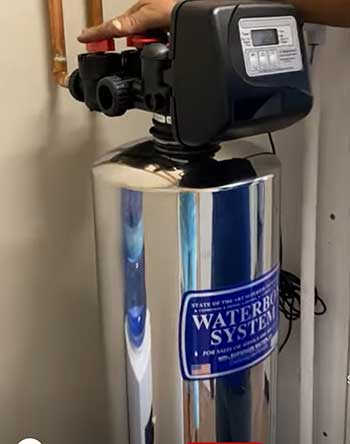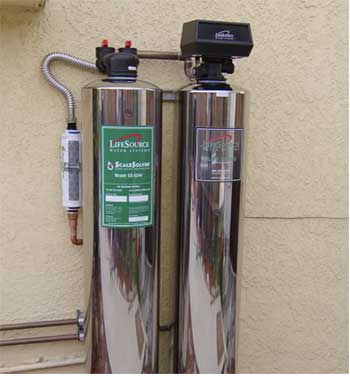Clean, contaminant-free water is essential for health. But with all the options for whole home water filters, how do you pick the best system? Two popular brands to consider are Waterboy and LifeSource.
In this comprehensive guide, we’ll compare Waterboy and LifeSource filters to help you determine which is better for your home. We’ll look at:
- Filtration technology
- Contaminant removal
- Installation and maintenance
- Filter lifespan and warranty
- Pricing
- And more!
Whether your goals are removing sediment, chlorine, or specific contaminants, this breakdown will provide key insights so you can choose the ideal whole home water filter system for your needs. Let’s dive in!
A Brief Comparison Table
| Feature | Waterboy | LifeSource |
| Filtration Method | Multi-stage (up to 7 stages) | Single tank filter |
| Contaminant Removal | Wider range including chemicals, microbes, fluoride | Good for sediment, chlorine, VOCs, metals |
| Installation | More complex with multiple tanks | Simple single tank |
| Maintenance | Multiple filters to replace | Just one cartridge to change |
| Cost | $2,000-$4,500, more expensive upfront | $800-$1,200, cheaper upfront |
| Warranty | Limited lifetime, 5-10 years on parts | 10 years on tanks, 5 years on most components |
Overview of Waterboy and LifeSource

Waterboy and LifeSource both offer whole home water filtration systems that connect to your main water supply.
Waterboy uses a multi-stage filtration process while LifeSource relies on a single tank filter design. We’ll explore the implications of these technologies shortly.
Both companies advertise removing a wide range of common water contaminants. They also emphasize easy installation, low maintenance, and longevity.
But there are some notable differences between Waterboy and LifeSource when it comes to specific filtering capabilities, warranty policies, and pricing.
Comparison Between Waterboy and LifeSource
Filtration Technology
The filtration method is where Waterboy and LifeSource differ most significantly.
Waterboy utilizes a multi-stage filtration process with up to 7 stages depending on the model. Stages include sediment pre-filters, KDF media for heavy metals, carbon block filters, RO membrane, and UV light disinfection. Their systems incorporate 2-3 tanks for the different filter stages.
LifeSource uses a single tank design containing a radial flow carbon block core surrounded by KDF media. All filtration happens as water flows through this one tank.
Waterboy’s multi-stage approach provides more comprehensive contaminant removal. But LifeSource’s single tank is easier to install and service.
Waterboy’s system may also require more maintenance with multiple filters to change. But the multi-stage process ensures better water purity and quality.
So Waterboy is the winner for more thorough filtration, while LifeSource offers simplicity.
Contaminant Removal

When it comes to the contaminants filtered, Waterboy and LifeSource share similarities but also some key differences.
Both effectively reduce:
- Sediment and particulates
- Chlorine and Chloramine
- Volatile organic compounds (VOCs)
- Heavy metals like lead and mercury
Waterboy also successfully removes:
- Bacteria and microorganisms
- Pharmaceuticals
- Pesticides and herbicides
- Fluoride
- And more
The additional reverse osmosis stage allows Waterboy systems to eliminate more dissolved solids and chemicals. Their UV disinfection kills nearly 100% of microbes.
LifeSource does not filter out bacteria or provide comprehensive chemical reduction like Waterboy models. Their single tank design limits overall contaminant removal.
So for whole home filtration of a wide variety of contaminants, Waterboy is the superior choice. LifeSource still effective reduces common issues like sediment, chlorine, and heavy metals.
Installation and Maintenance
When it comes to integrating your new system, Waterboy and LifeSource aim for straightforward installation.
Waterboy – Their modular multi-stage design allows flexible installation configurations. Units mount on the wall taking up minimal space. No drain connection is required. Their 3-stage systems are simplest to install. More stages add complexity.
LifeSource – Their single tank connects via just 3 ports to inlet, outlet, and a drain. Compact size and only one filter makes installation uncomplicated.
For maintenance, LifeSource wins for convenience. You only need to periodically change the single filter cartridge.
Waterboy requires replacing multiple filters on different schedules based on stage. Their re-mineralization stage may need occasional media replenishment. More maintenance is the tradeoff for superior filtration.
So LifeSource gets points for easiest installation and upkeep. But Waterboy’s superior contaminant removal may warrant the extra effort.
Also Read: Comparison Between Berkey And Hydroviv.
Filter Lifespan and Warranty
Both brands advertise their filters as designed to last years before needing replacement. But specific lifespans vary.
Most Waterboy filters last 1-5 years, depending on stage. Their sediment pre-filters require the most frequent change at 1 year. RO membranes and UV lights go 5 years.
LifeSource carbon block filters have a 2-5 year lifespan. Their KDF media doesn’t require replacement.
For warranties, Waterboy provides a limited lifetime warranty covering defects in materials and workmanship. Their filters, RO membrane and UV are covered separately by 5 or 10 year warranties.
LifeSource offers a 30 day money back guarantee. Their tanks have a 10 year warranty. Most other components are covered for 5 years.
So in terms of longevity, Waterboy and LifeSource are comparable. But Waterboy provides better warranty coverage, especially on their filtration media.
Pricing
When it comes to upfront costs, LifeSource systems are more affordable while Waterboy offers better value long-term.
Waterboy – Initial purchase prices range $2,000-$4,500 depending on the model. Their top-of-the-line systems with 6+ stages cost the most. Replacement filters can be $150-$300 apiece.
LifeSource – Systems start around $800-$1,200 for the full kit. Individual filter cartridges are $150-$200 to replace.
Considering superior contaminant reduction and longer warranties, Waterboy delivers better value per year despite higher upfront investment. LifeSource is the budget-friendly option.
Also Read: Comparison Between Aquasana And LifeSource.
Frequently Asked Questions (FAQ)
LifeSource whole home filters are not a full replacement for a water softener. While LifeSource does reduce some mineral content with their KDF media, their systems do not substantially soften water by removing calcium, magnesium, and other hardness minerals.
To fully soften hard water, you would still need a separate water softening system or consider a Waterboy filter with reverse osmosis. LifeSource improves water quality and taste but does not provide the same scale reduction and soap lathering benefits as a true water softener.
Some of the top brands for whole home water filters are Waterboy, LifeSource, SpringWell, Aquasana, and Pelican. Waterboy offers the most thorough filtration with multi-stage systems.
LifeSource provides quality reduction at a more affordable price point. SpringWell, Aquasana, and Pelican are also reputable brands that offer comprehensive contaminant removal.
The best brand depends on your water quality needs and budget. Comparing brands like Waterboy and LifeSource in detail is recommended to find the optimal whole home filtration solution.
Waterboy whole home filtration systems range from $2,000-$4,500 depending on the model. Their entry-level 3-stage systems cost around $2,000. Mid-range models with added stages like carbon filtration and UV treatment are $3,000-$4,000.
The top-tier systems with 6+ stages including reverse osmosis and remineralization filter are $4,000-$4,500. Replacement filters for each stage range from $150-$300 and need to be changed approximately every 1-5 years depending on the media.
Despite the higher upfront investment, Waterboy systems provide excellent value for their extremely thorough water filtration over time.
The best home water filtration technology is a multi-stage or whole house system. Multi-stage filters like Waterboy allow for the most comprehensive contaminant removal through the combined use of sediment filters, activated carbon, UV sanitization, reverse osmosis membranes, and remineralization. This technology covers both particulate and dissolved contaminants most effectively.
Single tank systems still provide quality filtration but cannot treat as many water quality issues. For the best home water purification, multi-stage filters that utilize a variety of proven technologies deliver superior filtration and peace of mind.
Also Read: How Do EveryDrop Water Filter 1 and Filter 2 Compare?
The Bottom Line
To summarize the key differences:
- Filtration method – Waterboy uses multi-stage, LifeSource has single tank
- Contaminant removal – Waterboy filters more comprehensively
- Maintenance – LifeSource is simpler, Waterboy requires more filter changes
- Cost – LifeSource is cheaper upfront, Waterboy offers better long-term value
Ultimately, Waterboy is the winner if top-notch water purity is your priority. Their systems filter out more contaminants with their multi-stage process.
LifeSource is a quality option if you want simpler maintenance and installation at a more affordable upfront cost. Their single filters still remove many common water issues.
To choose the best whole home water filter for your needs, take into account your budget, technical skills, and specific filtration goals. Use this comparison as a guide to determine if Waterboy or LifeSource is the right fit. Your family will enjoy cleaner, healthier water for years to come.

